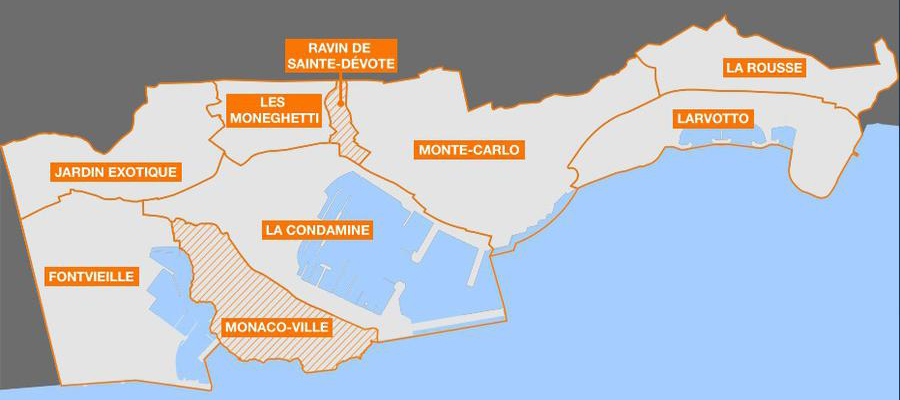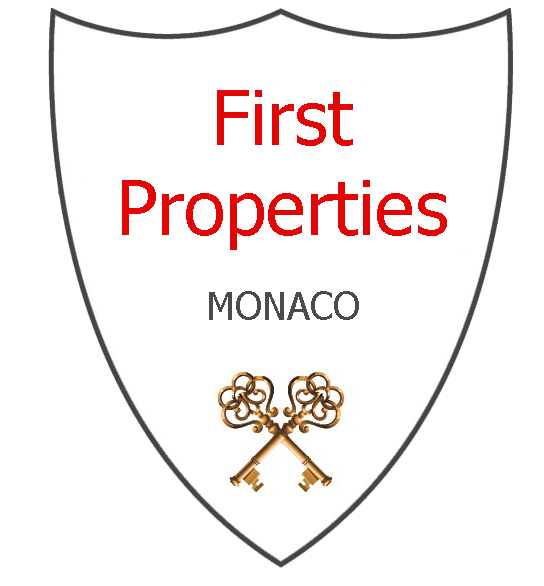Principality of Monaco
Independent and sovereign state, the Principality of Monaco is bordering with four municipalities of the French department of the Alpes-Maritimes (from west to east: Cap d'Ail, La Turbie, Beausoleil and Roquebrune Cap-Martin) and has a facade on the Mediterranean . It is located just 30 kilometers from Nice International Airport and 20 kilometers from Italy.
Its surface area is 195 hectares (about 2 km²), of which nearly 40 hectares have been sown on the sea in the last 20 years. It stretches along a narrow coastal strip of 4100 meters culminating at 163 meters. Its width varies from 1050 meters to 350 meters.
1. Neighborhoods
The Principality of Monaco is divided into seven scheduled districts and two reserved areas:
- Monaco-Ville on the Rock, the old fortified city, with the Prince's Palace, the ramparts, the gardens, the Cathedral and the Oceanographic Museum;
- Condamine, the district of the Port;
- Monte-Carlo, founded in 1866, under the reign of Prince Charles III who gave it its name, with its world-famous Casino, its large hotels and leisure areas, recently built: the Larvotto beach, the Monte-Carlo Carlo Sporting Club, the gardens of Boulingrins;
- Fontvieille, a major technical achievement with rockfill, on 40-meter grounds, a 22-hectare median that supports an urban, tourist and sports complex adjacent to a marina and a non-polluting industrial area.
- Exotic Garden (west border with Cap d'Ail): overlooking the Principality. This is the Jardin des Plantes district but also the Princess Grace Hospital and the Moneghetti shopping area. Beautiful buildings like the Ligures, the Patio Palace or the Harbor Light Palace offer a panoramic view of Monaco and the sea.
- Larousse: is on the eastern border of Monaco against the city of Roquebrune Cap Martin. It is home to many buildings such as Monte Carlo Sun, Parc Saint Roman, the Annonciade Tower or the brand new Odeon Tower.
- Larvotto: Monaco's postcard with its waterfront buildings and immediate proximity to beaches, Jimmy'z, Grimaldi Forum, restaurants and bars by the sea. Among other things, you will find the 21 Princess Grace, the Vallespir, the Columbia or slightly recessed, the Florestan
- Ravine of Saint Devote

2. Some demographic data
The population of the Principality counts (according to the official census of 2016) 37,308 inhabitants, who include 8,378 Monegasques, 9,286 French, 8,172 Italians. More than 139 nationalities are represented. Monaco and all bordering municipalities represent a population of approximately 95,515 inhabitants.
Monaco is a city-state open to the world. French is the official language, but Italian and English are also commonly understood and spoken. The Monegasque language is used by the elders and taught to the youngest in the schools of the Principality.
3. A bit of history
The first traces of life in Monaco date back to around 300,000 BC but its history really begins in the 13th century.
June 10, 1215 marks the birth of the future Principality, that day, the Genoese family of Ghibellines laid the foundation stone of the fortress that is today the Prince's Palace.
On January 8, 1297, François Grimaldi said Malizia (François la Malice) seizes the fortress under a disguise of Franciscan monk. On the coat of arms of the principality are traces of this origin with the two monks holding a sword.
The authority of the Grimaldi was finally recognized in 1314, and has continued until today with the sole exception of the period of 1793-1814 during which Monaco was incorporated into France, under the name of Fort Hercules.
The Prince of Monaco has full powers (absolute monarchy) until the granting of the constitution of 1911, which makes the country a constitutional monarchy.
In 1962, a new constitution is drafted. It governs the political and institutional regime of the Principality and enshrines the public rights and freedoms recognized to Monegasques and foreigners.
In 1971, the first stone of the district of Fontvieille was laid, which will increase the area of Monegasque territory by 20% by gaining on the sea.
In 1993, Monaco officially became a member of the United Nations.
In 2002, a new treaty between France and Monaco stipulates that the Principality will remain an independent state in the event that there is no descendant in the dynasty.
In 2004, the Principality of Monaco joined the Council of Europe.
On April 6, 2005, on the death of Prince Rainier III, his son Prince Albert II (born in 1958) became Sovereign Prince of Monaco.
On July 1st and 2nd, 2011, the wedding ceremonies of Prince Albert II with Princess Charlene take place.
December 10, 2014, LL.AA.SS. Prince Albert and Princess Charlene announce the birth of S.A.S. Hereditary Prince James and Princess S. Gabriella.
The Grimaldi dynasty has presided over the destinies of the Principality of Monaco for more than seven centuries. This longevity illustrates the national unity of the Princes and the Monegasque people.
4. A privileged climate
Principality of Monaco Benefiting from exceptional sunshine, the Principality of Monaco has mild winters and summers without excessive heat. Indeed, in sixty years of meteorological observations, the average temperature rises to more than sixteen degrees. The number of rainy days does not exceed 87 per year and the average annual sunshine is 2.583 hours, or 7 hours of sunshine a day. The temperature of the sea ranges from 26.5 degrees in mid-summer to 11 degrees in winter. This climate, Mediterranean par excellence, makes Monaco a prestigious site, where life is pleasant throughout the seasons. It should be noted that ski resorts in the Southern Alps are less than an hour away by car.
5. Infrastructures
Despite its small size, Monaco boasts a variety of facilities: a heliport, the Louis II Stadium, inaugurated in 1985, the Monte Carlo Country Club with 40 courts, Olympic swimming stage called Nautique Rainier III, recognized institutions such as the Academy Music Rainier III Academy of Classical Dance Princess Grace, the Municipal School of Plastic Arts, many theaters and museums such as the Oceanographic Museum, a high density of financial institutions s meeting the imperatives of demanding customers , many schools (public, private, international), a university, an incomparable security in the world that make Monaco a haven of peace particularly appreciated.
6. Major events
The Monegasque cultural scene is prosperous. Among the main events:
- appointments prestigious sports (such as the Formula 1 Grand Prix, the Grand electric Prix, Historic Grand Prix, the tennis tournament Monte Carlo Rolex Masters, the Monte Carlo Rally, or the Jumping International de Monte Carlo).
- many musical and artistic events (such as the International Festival of Monte Carlo Circus, New Generation, concerts and festivals, exhibitions, ballets of Monte Carlo, the Philharmonic Orchestra, the World Festival of Amateur Theater)
- unmissable events such as the Monaco Yacht Show
7. Traditions
The motto of Monaco and its Princes: "Deo Juvante" (With the help of God) The Catholic religion is the state religion. However, freedom of religion is guaranteed by the Constitution and many confessions are present in Monaco.
The Patroness of Monaco is Sainte Dévote, a young martyred around the year 304 in Corsica, in Lucciana (city twinned with Monaco since 2008). His body, deposited on a boat by fishermen, would have been stranded on January 27 on the shore of Monaco.
The National Day is celebrated every 19th of November in honor of Prince RAINIER III.
Other festivals, such as Saint John (June 24), Saint Roman (August 9), St. Cecilia (November 19), St. Nicholas (December 6), U Pan Natale (December 24), the procession of Christ-Death (Good Friday), show that despite being a very modern country, Monaco remains a country very attached to its traditions.
